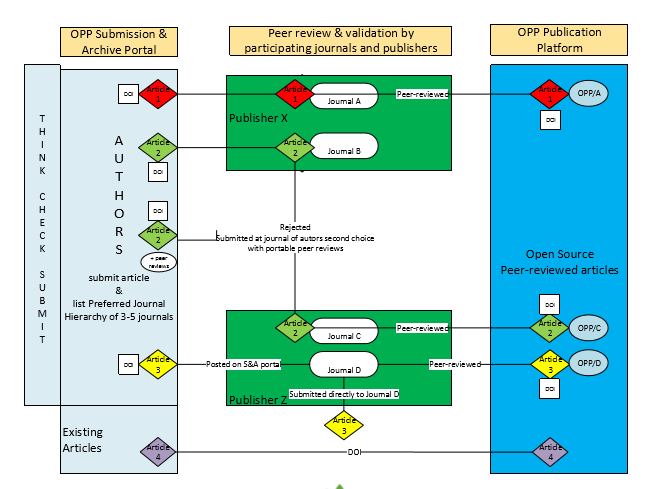Preprints and peer review
Preprinting is a quite common practice across a range of disciplines. What quality control mechanisms exist to ensure the good quality of a preprint?

As traditional publishing and its peer review methods proves to be a lengthy process, preprints offer speedier dissemination accelerating scientific progress. It carries several benefits for scholarly communication being more fair, open, and transparent with peers and the public (Enago publishing, 2018). Despite the fact that preprint content enables fruitful discussion and feedback from volunteer peer reviewers and commenters, it is criticized as a publishing methodology due to the lack of organized peer review connected to it (Amaral, 2018). The quality control mechanisms added to preprints could also help to identify and filter out low quality.
Preprint servers
The emergence of preprint servers indicates a trend and a need for early communication and registration of research findings. These platforms typically run internal checks to ensure that the posted work is of scientific nature. Social platforms such as ResearchGate or Academia are also used for preprint posting, but they are different in terms of their purpose. Publishers are more and more establishing new methods to link preprints and the final journal version of the record to make scientific discovery more open.
Among the advantages of disseminating research results via preprints, we can include immediate dissemination, wider recognition of achievements in grant proposals, shifting copyright ownership to authors, increase discoverability of related outputs through DOI. The practical challenges of preprint dissemination are related to a variety of issues including technical and social aspects of publishing. Researchers carry fears of having their ideas scooped, which indicates that sharing involves taking risks and feeling vulnerable of plagiarism. The technical challenges also include version consolidation and increasing the discoverability of preprints in different disciplinary communities (Görögh, 2018).
There is a common concern that preprints may be less reliable than peer-reviewed articles. Papers from preprint repositories are cited and used in research, but still they have the disadvantage of lacking a peer review evaluation attached to them. There are several initiatives, which attempt to overcome this problem by introducing peer review solutions to preprint depositing.
ASAPbio (asapbio.org) recommends a scientist-driven, journal-agnostic peer review service that produces an Evaluated Preprint and facilitates subsequent publication in a journal. After submitting the work to a preprint server or Peer Feedback, researchers request evaluation. The authors suggest a list of possible referees and Peer Feedback will select and contact referees. It is a fee based service, so authors are charged a fee from which reviewers are compensated for their work. The Evaluated Preprint can be included in grants, job applications, and promotions, and can also be submitted to journal publication. Articles going through Peer Feedback are envisioned to go through another review only for journal suitability. This system promotes better journal matching with less rejection since editors will have better information on the submission (Vale, 2018).

Figure 1: Peer Feedback. Source: Vale, R., Hyman, T. and Polka J. (2018). Peer Feedback. ASAPbio
Due to disciplinary differences and various journal policies, posting the preprint version of a manuscript and then submitting it to scientific journals for publishing are not always compatible processes. But, ASAPbio provides an excellent example of how preprint depositing complements journal publishing in the field of biology.
Open platforms
The European Commission plans to launch an open access publishing platform (Open Research Europe) which will also host preprints as an add-on feature. It was founded as a reaction to the European Commission’s call for tender to build an “Open Research Europe Publication Platform.” Some scepticism was expressed among researchers about this initiative. The publishing platform will be available to the beneficiaries of all scientific projects financed by the European Commission, and will provide an open access publishing venue managing the entire publication process with an open peer review system. The question arises how its use can be incentivized among researchers. Lack of integration and seamless transition between multiple platforms may lead to the loss of focus and to fragmentation.
As an alternative approach, the TTOA has proposed the development of the “Open Publication Platform (OPP)”, which consists of two pillars: (1) a submission portal that serves as a preprint publication channel and channels articles to the journals preferred by the authors. Peer-review reports are portable and are carried along with the paper from one journal to the next, with authors revising their paper as a function of the reviews, and (2) a modern platform hosting the journals’ peer-reviewed and published articles. All publishers in the TTOA Consortium have agreed that the publication fee will not exceed €1400 per article on average (TTOA, 2018).

Figure 2: Peer review connected to preprint dissemination. Source: https://www.fairopenaccess.org/wp-content/uploads/2018/05/Public-statement-TTOA-consortium-30may18-def.pdf
In order to realize the full potential of preprint publishing in the future, several issues should be addressed. Preprint would be valued more if linking between preprints and peer reviewed publications was a common feature. We need clear guidelines and policies on the use of preprints, and standards and licenses for processes on submitting, sharing and re-using preprint materials (e.g. COPE). Furthermore, educating researchers with regard to the licenses and publishers policies on preprint dissemination could clear the confusion about this form of publishing.
References
Amaral, O. (2018). Comparing quality of reporting between preprints and peer-reviewed articles – a crowdsourced initiative. ASAPbio blog. Retrieved 20 July 2018 from: http://asapbio.org/amaral-quality
Enago publishing. (2018). Preprints: Does Publishing Research Early Have a Downside? Retrieved 6 August 2018 from: https://www.enago.com/academy/preprints-publishing-research-early-downside/
Görögh, E., Schmidt, B., Banalyte, V. (2018). Open science beyond open access and research data (Workshop 1). ERCEA/A1/PO/2016/06
TTOA Consortium. (2018). The Consortium for a Transparent Transition to Open Access (TTOA): A cost-transparent combination of old and new. Public statement. Retrieved 3 July 2018 from: https://www.fairopenaccess.org/wp-content/uploads/2018/05/Public-statement-TTOA-consortium-30may18-def.pdf
Vale, R., Hyman, T. and Polka J. (2018). Peer Feedback. ASAPbio. Accessed on July 10, 2018: http://asapbio.org/peer-feedback



